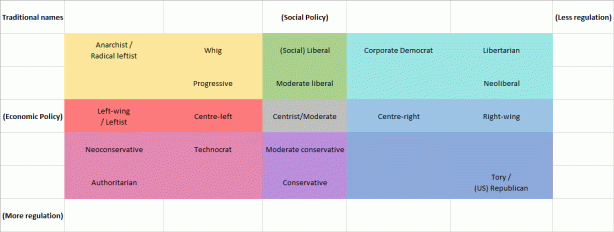I talked yesterday about what is the most urgent electoral reform in New Zealand, which is to dramatically lower the Party Vote threshold, preferably all the way to about 0.8%1
Kiwis have a recent tradition of liking electoral reform. We have a real streak of fair play about us, from wanting a more liberal and egalitarian society generally, to voting for smaller parties just to “keep the buggers honest.” We not only put national elections on a mostly-proportional MMP system, but we also implemented STV wards in some cities on local councils and for DHBs, and even an IRV2 vote for mayor in a couple places, too.
I attempted to canvas some party positions on social media yesterday, however I haven’t yet had any replies. The only electoral reform announcement we had recently was an old labour policy to implement the MMP review’s recommendations of a 4% threshold and removing the electorate lifeboat provision3. I will come back to this if I get some replies, so unfortunately I don’t have any concrete proposals from this election to talk about, but I will instead give you some ideas about where we could head in the future, while still keeping the best aspects that we as a country seem to like about MMP.
Electoral reform is a tricky thing to talk about, as to be really honest about it, you need to keep a mind to Rawls’ Veil of Ignorance in considering it4. I am being consistent in saying this, because although it’s currently the Greens and TOP facing a polling result near the threshold, we have had parties I dislike (more than TOP) facing that before and I have clearly said the threshold is wrong every election that has happened. The specific ones I am thinking of are New Zealand First and the Conservatives, but there was also a Christian party back in the day that merited a single list seat but didn’t get it. So let’s ignore for a moment what specific parties that would benefit from these proposals, and talk about Making MMP better, or even Transitioning From MMP to something even better.
Treat independents as overhang seats
Right now, there are different rules for Independent candidates winning an electorate, and parties that win more electorates than their Party Vote entitles them to list seats for. (I’ll call them “overhang parties” from now on) Currently, only those overhang parties get overhang seats.
Independents remove the 120th (and then 119th, and so on) list seat from Parliament right now. It hasn’t been a problem yet, because we haven’t had any independents in Parliament that haven’t simply split off from other parties since MMP, but I’m coming back to propose systems that will make them more attractive to elect, so this might be relevant if we go for those reforms, and besides, it’s simply daft to have different rules for each of them when our system to date has delivered for many more overhang parties than it has independent candidates winning electorates. And in terms of picking which rule we should use in both situations, I think it makes sense to use the rule whose results are easier to predict- it’s much easier to know what happens to parliament if we add an overhang seat than if we remove a list seat, and it actually violates proportionality less if add an extra seat, too.
The only good reason not to add overhang seats is if you’re worried that there could be so many that it drastically inflates the number of MPs and swamps the proportionality of Parliament. Right now, there is no indication that this is a serious worry.
Switch electorate votes away from FPP
MMP as we know it now is essentially a hybrid of two political systems, a Closed List system for the Party Vote, and 16x(1+ratio of North Island population to South Island population6) FPP electorate contests that can let people vote in candidates that might not be placed in winnable positions on their party’s list, or just guarantee smaller parties make it into Parliament.
While there’s no precedent for doing so, we could absolutely switch to IRV, STV, RV, or RRV for candidate votes in the medium term, or just because we like having MMP and want to make it better. Let’s go through them in three batches, as IRV and RV are the single-winner cases of STV and RRV and only need to be mentioned for their differences.
Such a system would technically no longer be MMP, (in fact, there’s no name for Closed List hybrids with anything other than FPP yet, so we’d get to invent it) although mostly it would function the same way.
The case for Single Transferrable Vote
STV would give us larger electorates, probably with 3 to 7 winners in each one. You would likely want to set a quota of at least two electorates for the South Island, and set a maximum of at most 55 electorate seat winners.
Each voter ranks as many candidates as they like when voting, but must write at least one number on their ballot to cast a valid vote5. When counting the votes, a “quota” is set to determine winners, an example quota is: 1 / (number of winners) + 1. So a three-winner electorate would require a candidate to win a quarter of the vote, assuming there are more than three valid candidates. (if there are only 3 or less, they are all automatically elected)
Then the votes are counted in rounds. Any candidate over the quota is elected immediately, and a new round begins. If no candidate is elected that round, the least popular candidate is eliminated.
In every subsequent round, the eliminated candidates have all their votes with lower preferences redistributed, and all votes with no valid lower preferences that can’t be redistributed are removed from the total. If a candidate was elected, a similar process is followed whereby their excess votes above the quota are fractionally redistributed. (ie. we look at where every vote for that candidate would have gone if they had been eliminated, and apply that as a ratio to their excess votes only)
We keep going through rounds until we have enough winners or we’re down to our last winner needed and only two candidates are left, in which case the most popular one with redistributed votes included wins the last seat.
STV is good in that your vote will, for practical purposes, likely count for at least one winner as long as you’ve ranked more candidates than there are available seats. It is largely immune to vote-splitting, although technically it can happen in certain edge cases. It’s also very hard to strategically vote in STV, as you would need hyper-accurate polling and a very close race in one of the rounds for it to be worthwhile.
But it has problems with expressiveness, complexity, and counter-intuitiveness: For instance, ranking every candidate and putting the ones you don’t like near the bottom can actually help candidates you ranked near-to-last, but it’s not obvious that you shouldn’t do this. Instead any candidate you don’t want to help, you should leave off the list.
Secondly, your vote becomes more effective if your list is longer. This isn’t obvious until you consider the fractional redistribution- that is, people who know what every single candidate is like and can list them all in order are more likely to effectively utilise the bonus of fractional redistribution of their vote. This means that the votes of high-information voters literally count for more, rather than simply figuratively counting for more where there’s an opportunity to vote strategically, so it kind of makes up for its relative immunity to strategic choices.
Thirdly, STV has some odd effects where ranking a candidate higher under certain circumstances can cause them to lose. It’s a result of its round-by-round tallying system. It’s also too complicated to be practically counted by hand, (arguably not a problem in terms of budget or practice, but really we should have a voting system where a winner can be declared even during a power cut) and you can’t provide provisional results. In short, it doesn’t get early results out very easily.
Having larger STV electorates would likely mean that each electorate would have at least one National and Labour winner, and we’d likely have a fair amount of Green and NZ First electorate winners, too. It would be harder to campaign for each electorate, but easier for more diverse winners to be picked. This would likely be good for non-Māori minorities as well as for smaller parties.
The case for Re-weighted Range Voting
RRV, or Re-weighted Range Voting, like STV, is a system designed for multiple winners, and it also uses rounds to determine its winner, although in a more limited way. You would likely want to set similar electorate sizes and quotas as for STV.
When voting, you would put a number in an arbitrary range (such as between 1 and 9, or 1 and 99. There are minor differences based on what range you select- eg. odd numbers without 0 let you evaluate a candidate as average, and larger ranges are more expressive, but more difficult to count, than smaller ranges) next to as many candidates as you wish, with higher numbers being better. It’s a more expressive system, because technically any number below average allows you to vote against a candidate, marking them as sub-par.
Some variations also take special consideration of candidates with no number next to them, or allow you to mark a cross next to them to indicate you’ve deliberately not voted for them. In those variants, you’re essentially saying you don’t know a candidate well enough to evaluate them. If plenty of people evaluate them anyway, that candidate’s rating is considered for winning a seat, but if a certain threshold of people don’t, say 75%, then they’re removed from consideration, so that you don’t get just a few enthusiasts electing an obscure candidate.
When the votes are counted, the first round proceeds as in normal Range Voting: An average is calculated for each candidate, and the candidate with the highest average (assuming they’re not disqualified for too few voters evaluating them) wins the first seat.
However, after this, each unique combination of votes is re-weighted according to a criteria. (there are several, each one effectively a different electoral system. The one I find most useful is “divide by distance above average,” so I’ll discuss it specifically from here)
In the second round we come up with a weighted vote for all candidates according to the criteria. In this specific example, everyone who voted for the first winner has all their remaining choices de-weighted, based on how enthusiastic their support for that winner was. (in 1-9 votes, this would be everyone who rated the winner 6 or above.) The next winner is selected based on the average of the weighted support, so that you don’t just get a tyrrany of the majority. This tends to spit out candidates proportional to popular support, but it also advantages compromise candidates, too. A candidate that everyone rates as 7/9 is much more likely to be a winner than one that 60% of voters rate 9/9 and 40% rate 1/1, because they’ll average out to somewhere around 6/9. Range voting works well this way because it penalizes controversy in balanced electorates, (other than of course, natural inclination away from boring politicians that penalizes centrists in general) but rewards it in unbalanced ones.
We keep re-weighting the votes based on the number and degree of support for winners, then picking a new winner until all the vacancies are filled. The weighting for the third and subsequent rounds is based on whether your original rating for a candidate was above average, not if the currently weighted value is above average.
This has several good effects:
- The re-weighting algorithm incentivises you to be brutally honest about how much you support each candidate you think is likely to get elected, as you get “punished” less for a compromise candidate being elected, and not at all if you vote someone as average or lower. It arguably doesn’t punish you from exaggerating your support for a candidate you want/expect to win in the last round, however.
- Compared to other RRV criteria, there is no perverse incentive to rate all candidates you dislike as 1s, which happens if your criteria includes increasing the weight of votes below the average, or decreasing the weight of all votes above the minimum.
- How you evaluate one candidate has no direct effect on other candidates in the first round.
- You can rate two candidates exactly the same, unlike in STV where writing duplicate numbers invalidates your list from that point on.
- You can express the difference in your support between several candidates by having larger jumps between your ratings than a listed vote would allow, unlike STV where missing a number invalidates your list from that point on.
- The winners will be proportional to both the reported enthusiasm of voters and their popularity with voters, making “displeasing nobody and pleasing nobody” a losing strategy.
- There is no inherent advantage to rating more candidates, so the system respects low-information voters and treats them equally.
It also has some bad effects, mostly shared with STV:
- It’s difficult, although not as practically impossible as with STV, to calculate the winner by hand.
- Polling places have to report a count of each unique combination of votes, and as counting is done in rounds, you can’t release provisional results.
- There is a disadvantage to rating more candidates above the average, as you become statistically more likely to have included the winner of an extra round before you get to the last round. (however, if you have good reason to believe that a candidate won’t win until after the candidates you most prefer, then the risk is lower in providing an honestly positive vote) This disadvantage becomes more prominent the larger the number of vacancies is in your electorate.
- It makes electorates larger in compensation for giving you multiple winners.
The case for single-winner variants (IRV and RV)
Mostly, the case for single-winner variants, where we keep something like the current system, is the case for smaller electorates. You are more likely to capture communities of interest outside of large cities, and less likely to end up with large conglomerations of regional New Zealand.
Also, Range Voting is possibly the best single-winner system that exists, and unlike RRV, most of its disadvantages are arguably advantages. (ie. votes can count for less, but only if you decide to vote honestly in the mid ranges instead of voting 1s and 9s. It’s vulnerable to strategic voting, but basically turns into Approval Voting, also better than FPP, when that happens. (Approval is basically ‘tick as many candidates as you like’) It’s also not proportional, being a single-winner system)
I’m not a big fan of IRV, as in edge cases it’s actually possible for the candidate you ranked first to lose when they would have won if you ranked them second. (this is due to some oddity in the order of elimination being relevant. RRV suffers to this problem to a lesser degree as a system that also uses rounds, but it doesn’t really effect the final round of tallying, and arguably if you manage to get all your strongly preferred candidates elected, you no longer care about diluting the weight of later votes, and STV suffers from this problem in full force, as well) If we’re using a single winner system, it should really be RV.
Couple a move to a proportional electorate system with some tough love for micro parties
If we choose STV or RRV, our electorate choices should also be proportional, giving us a compromise between national proportionality and regional proportionality.
If we chose one of the multi-winner systems, we could reasonably require party-affiliated candidates to have their party meet the threshold to be eligible for election7. This would discourage de facto independents like Dunne or Seymour from running as “small parties” in order to get more media attention, and instead paint them as the local curiosities they are. It would also incentivise parties like the Māori Party to contest both the Party and electorate vote, making it a dangerous strategy to shoot for too large an overhang. Coupled with a lower threshold and reforms of the rules for independents, and this would actually be a reasonable move, rather than the punitive one that simply removing electorate lifeboat provisions would be. It would also allow us to elect genuine independent candidates without disrupting the proportional allocation of list seats.
Adjust the South Island Quota
If we’re keeping single-winner electorates, we probably need to adjust the minimum number for the South Island soon, as we’re arguably closing in on having a number of electorates high enough that Labour might start getting overhangs if it gets a low result, and the two largest Party Vote parties shouldn’t really risk winning overhang seats. If we’re forming multi-winner electorates, we’ll need to adjust it anyway, because we’ll need to include language about both the number of electorates and the number of winners the South Island should get.
One way to do this is simply to say that the proportion of electorate seat winners in the smaller island out of North and South should be equal to at least their proportion of total voters when the boundaries are set, but that there shouldn’t be a disparity of more than, say, 25% of that ratio. Then set a minimum and maximum to electorates in general- say that there should be no less than 40 electorates, and no more than, say, 55. This sets the rules in a way that works no matter what the demographics of each island are. (although it does seem unlikely that the North Island will ever have a smaller population, it’s not impossible that we get a large volcano erupting or something that drives people south) It also slightly over-represents the location where less people are, which seems fair so long as it’s only slight, given that they are still likely to get geographically very large electorates with disparate values.
Ditch electorates altogether and replace them with another way to directly vote
This one’s my favourite, but I think it’s a long shot, as New Zealanders are irrationally attached to their idea of “their local MP” thanks to decades under FPP. It might be practical once I’m old and everyone is more attached to list voting than they are now.
I talked about the list part of MMP being a “closed list” system. There is, of course, a perfectly proportional system with a built-in accountability method that’s still based on Party Voting.
It’s called, appropriately, “Open List.” The open part comes from the fact that while parties still provide their lists of candidates, you’re actually allowed to vote on them directly as a voter even after the internal selection processes have been finished. Currently, the Greens let members vote on their list, but they’re the only party that does it, as there simply needs to be some sort of “democratic process,” according to the law. In practice, this means you can simply have the party leaders choose their own delegates, and the delegates vote on candidate selection, which is just a roundabout way of doing backroom deals.
You can get variations on this system, based on how you handle list voting, for instance, you could leave ordering the candidate lists entirely up to the voter, and you could handle voting on them using any multi-winner system. (my two preferred options are listed above, RRV and STV) You could have the lists voted on as a primary, then hold a second-round general election with just a simple party vote, allowing low-information voters to skip the first round while still being heard in the second, or you could have a recommended list order from every party, and let people adjust it based on their votes on election day if they like.
You would likely still have candidates representing local regions, but it would be an informal arrangement, where parties genuinely have to campaign about issues popular in large enough regions to get moved up the list, rather than the arbitrary electorate boundaries we have now.
In Summary
To be clear, my interests in electoral reform are:
- Make representation more proportional in all senses. (ie. give fair numbers of MPs to each party, have roughly 50% of MPs be women, and representative numbers of various races, and from various regions of New Zealand. Obviously, there’s a bit too many things going on there to balance those factors with also electing the best qualified candidates, so we’d expect a little variance. That’s okay, so long as that variance is both up and down. Historically, it’s just been down for every group except men, Pakeha, and recently Māori)
- To provide avenues for smaller parties with popular ideas to grow into larger parties, so long as doing so wouldn’t adversely effect quality of government
- To remove barriers that discourage people from voting. (We are already mostly good on this front, we just need to consider what effect reforms will have on voter interest)
- To reduce the influence of rules that override the decisions of voters whenever doing so doesn’t adversely affect good media coverage of politics.
- To ensure that geographically disparate ideologies that are still a significant portion of the population get fairly represented in Parliament.
I think, with the possible exception of giving some tough love to micro-parties, that all of these suggestions don’t contradict any of these goals, and generally meet multiple of them. I would love to hear feedback.
I think an Open List is the best way forward for all of these, but I can’t see New Zealanders supporting it just yet.
(more…)

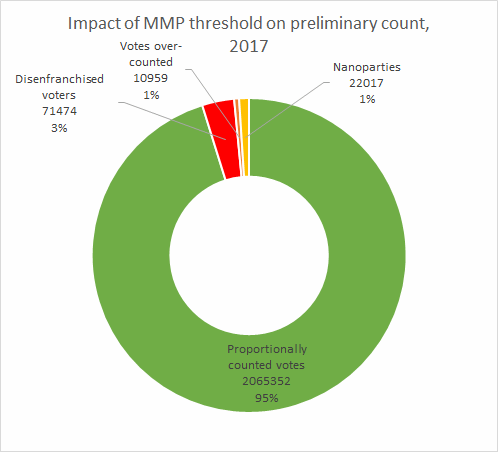 The good news is that it’s currently down on 2014. We’ll see if that remains the case after specials, which can favour smaller parties.
The good news is that it’s currently down on 2014. We’ll see if that remains the case after specials, which can favour smaller parties.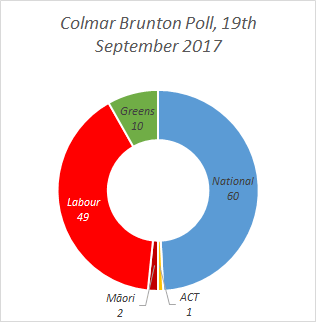 Let’s start by comparing the base seats we would expect to see in both of the major polls.
Let’s start by comparing the base seats we would expect to see in both of the major polls.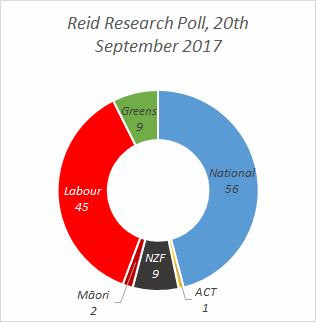 is capable of winning it on his own merits now as he is an incumbent, but assuming those things without a poll to back it up makes me very uncomfortable, and nobody polled Northland or Ilam this election, and these could reasonably be assumed to be key electorates. This scenario is a hung Parliament, assuming it is dead-on, (and of course, it won’t be) but once you factor in the margins of error, there are probably a lot more ways for a left-wing coalition to win than a right-wing one, as there are more ways for them to have been underestimated, if Peters did end up losing his electorate and below threshold.
is capable of winning it on his own merits now as he is an incumbent, but assuming those things without a poll to back it up makes me very uncomfortable, and nobody polled Northland or Ilam this election, and these could reasonably be assumed to be key electorates. This scenario is a hung Parliament, assuming it is dead-on, (and of course, it won’t be) but once you factor in the margins of error, there are probably a lot more ways for a left-wing coalition to win than a right-wing one, as there are more ways for them to have been underestimated, if Peters did end up losing his electorate and below threshold.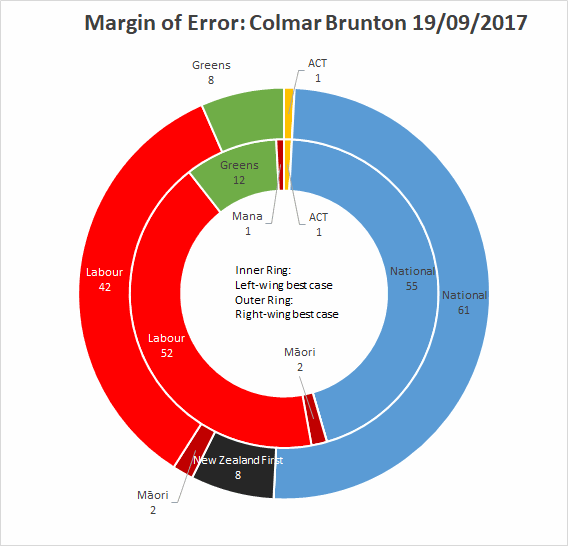
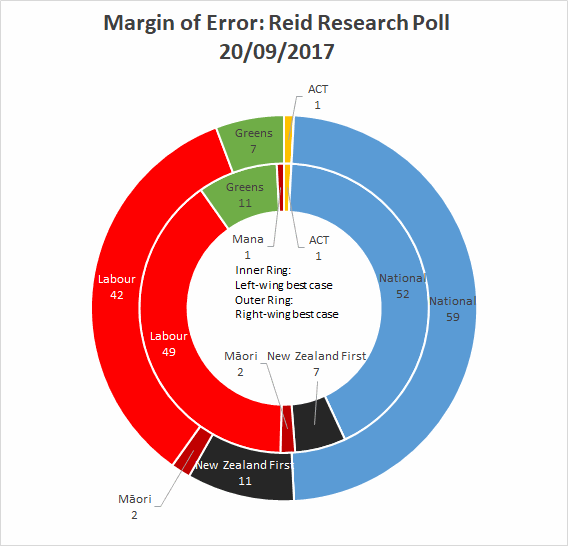
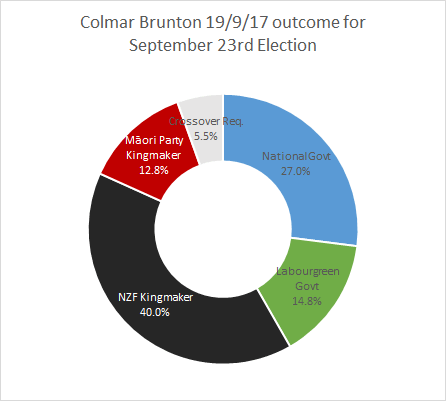
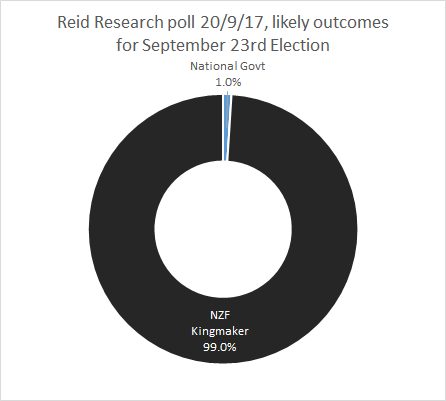 chance for ACT or the Māori party to lose electorates, and even for Mana to win Te Tai Tokerau)
chance for ACT or the Māori party to lose electorates, and even for Mana to win Te Tai Tokerau)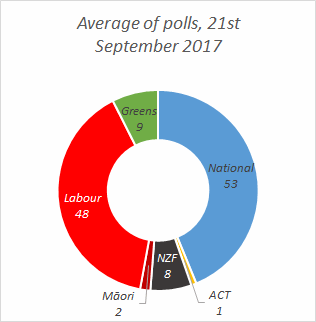 I have a healthy amount of skepticism about the changes to Reid Research’s poll methodology and the addition of online panels. While the two last results were superficially a bit similar, both the one-off Horizonpoll and Reid Research have been friendlier to National and New Zealand First than the other polls. It’s difficult to fairly compare Horizon without past results, but taken with its commonality with the two most recent Reid Research polls in showing either National or New Zealand First at unexpectedly high
I have a healthy amount of skepticism about the changes to Reid Research’s poll methodology and the addition of online panels. While the two last results were superficially a bit similar, both the one-off Horizonpoll and Reid Research have been friendlier to National and New Zealand First than the other polls. It’s difficult to fairly compare Horizon without past results, but taken with its commonality with the two most recent Reid Research polls in showing either National or New Zealand First at unexpectedly high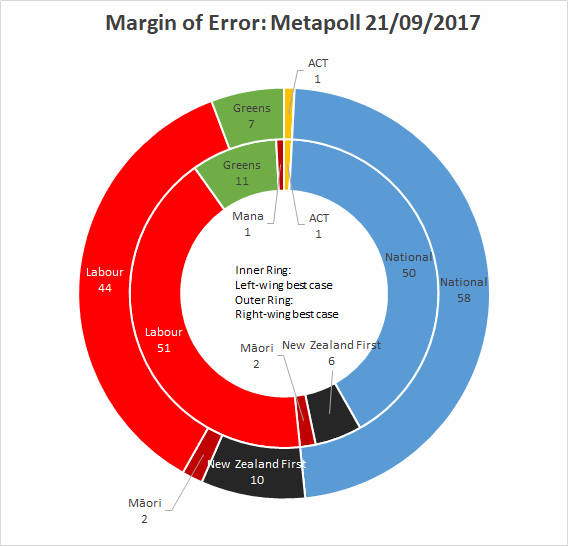 So that covers the last two polls. The average is, as you’d expect, somewhere between them, with a little weirdness thrown in from using the older polls to moderate them a little bit. When looking at the average we should consider the trend of the most recent polls, which both agree that Labour is dropping a bit, National is not as high as the two latest polls suggest, although maybe higher than the average does, that the Greens are rising, however they are in sharp disagreement about whether NZF is rising or falling, however not to the level where we can be sure the reality isn’t simply that they stayed still or rose very slowly from 6% to, say, 6.2%.
So that covers the last two polls. The average is, as you’d expect, somewhere between them, with a little weirdness thrown in from using the older polls to moderate them a little bit. When looking at the average we should consider the trend of the most recent polls, which both agree that Labour is dropping a bit, National is not as high as the two latest polls suggest, although maybe higher than the average does, that the Greens are rising, however they are in sharp disagreement about whether NZF is rising or falling, however not to the level where we can be sure the reality isn’t simply that they stayed still or rose very slowly from 6% to, say, 6.2%.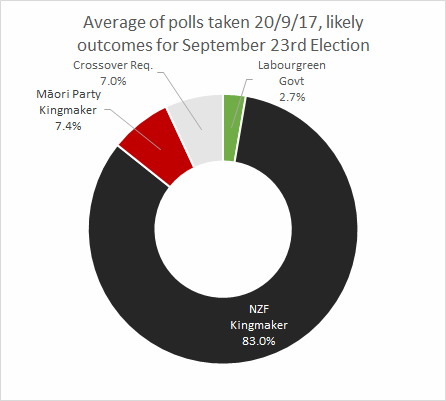 While it’s often said of the minor parties that NZF routinely underpolls and Greens routinely overpoll, this is not exactly true. What tends to happen is that NZF has an upward trend that may be explained purely in lag between the poll and changes in attitude of voters on election day, while the Greens are usually in a downwards trend on election day that might also continue. This year, NZF had been in a downwards trend until the very last poll, and the Greens were in a consistent upward trend, although all three big polling organisations disagreed as to how much. I wouldn’t be surprised if we see NZF poll at somewhere around 5-6%, and the Greens poll between 7-8%, but it’s possible that the saying really is true and we will see the reverse trend.
While it’s often said of the minor parties that NZF routinely underpolls and Greens routinely overpoll, this is not exactly true. What tends to happen is that NZF has an upward trend that may be explained purely in lag between the poll and changes in attitude of voters on election day, while the Greens are usually in a downwards trend on election day that might also continue. This year, NZF had been in a downwards trend until the very last poll, and the Greens were in a consistent upward trend, although all three big polling organisations disagreed as to how much. I wouldn’t be surprised if we see NZF poll at somewhere around 5-6%, and the Greens poll between 7-8%, but it’s possible that the saying really is true and we will see the reverse trend.